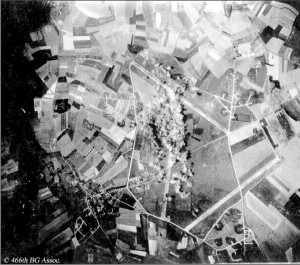The Clastres aerodrome was located on the northern edge of the village of Clastres, about __ miles south-south city of Saint-Quentin, France. The original Clastres aérodrome was built by the French Army in 1937. It covered an area of about 100 hectare runways. The Luftwaffe took over the Clastres aerodrome in 1940. In 1942 it began to greatly expand the facility, eventually 2500 meter runways, 42 hangars and, in the village of Clastres, barracks. Construction continued into 1944.
STRIK E PHOTO – August 8, 1944 – Clastres Aerodrome, France. Clastres was the target for the 100th mission of the 466th Bombardment Group; This photograph shows what appears to be a nice concentration of hits along the main runway. Over 124,000 lbs. of bombs were dropped on target. (USAAF)
E PHOTO – August 8, 1944 – Clastres Aerodrome, France. Clastres was the target for the 100th mission of the 466th Bombardment Group; This photograph shows what appears to be a nice concentration of hits along the main runway. Over 124,000 lbs. of bombs were dropped on target. (USAAF)
25 Aug 1944 Strike by the 367th Fighter Group
During and immediately after the Normandy invasion Allied forces had effectively surpressed most Luftwaffe activity. By August, however, therebegan to be a resurgence. As part of an effort to suppress it the three squadrons of the 367th Fighter Group, flying P-38 Lightnings, were ordered to simultaneously attack three separate airfields in the Laon area on August 22. The 392nd Squadron, led by Major Rogers, dive-bombed and destroyed two hangers on one airfield but were jumped by 12 FW 190s as it completed its attack. Maj. Rogers called the other squadrons for help. The 393rd was jumped by 18 ME 109s and FW 190s as they reformed from their dive bomb run. Lt. Buchanan shot down one but two Germans cornered Lt. Awtrey and shot off his canopy. Even without a canopy, Awtrey outmaneuvered the two and riddled one of them. Lt. Stanley Johnson called to report that his aircraft had been shot to pieces and he was bailing out; his parachute was seen to open but he was never heard of again. After bombing its target, the 394th Squadron, led by Lt. Pieper, turned to help the 392nd. His flight bounced four Germans but in turn was attacked by three others. One of the FW 190s shot out one of Lt. Pieper’s engines but was destroyed in turn by Pieper’s wingman, Lt. Lee. The fight continued with the 394th shooting down six additional aircraft including one destroyed by Lt. Pieper flying with one engine feathered. In the mean time, the 392nd had taken care of itself, destroying five enemy aircraft without a loss. Victories were by Lieutenants Hartwig, Kines, O’Donnel, Diefendorf and Markley. Altogether the Group had destroyed 14 enemy aircraft for a loss of one.
On August 25, 1944, the 367th Fighter Group, flying P-38 Lightnings, was sent back to the area for another simultaneous bombing of three airfields, this time at Peronne, Rosieres-en-Santerre and Clastres. The dive bombing attacks ignited one of the greatest fighter versus fighter air battles in U.S. history. It was unique in that most of the action took place in a relatively small area and from 3,000 feet to ground level. There are still witnesses to this dramatic event who refer to it as the “The day the sky over I’Aisne was on fire.” (See Chapter 12 of “Quand le Ciel de I’Aisne Etait en Feu” by Jean Hallade.)
The attack at Clastres was carried out by the 394th Squadron with 12 aircraft under the command of Major Grover J. Gardner. A German participant recalls that about forty patrolling Focke Wulf 190s of Gruppe II/Jagdgeschwader 6 spotted the 12 aircraft of the 394th and fell on them out of the sun, downing many in the surprise rush. The American version is that Major Gardner radioed the other two squadrons with the location of an estimated thirty Focke Wulf 190s that had just taken off and then, leaving Captain Charles F. Matheson’s flight to fly cover, lead his flight into the initial attack in which four FW 190s fell simultaneously; Maj. Gardner and the other three members of his flight were then quickly surrounded and shot down. At that point the cover flight arrived and a melee ensued: Captain Matheson shot down two FW 190s, Lt. Ross P. Lezie damaged one and destroyed another, Lt. Sydney S. Platt shot down one and Lt. Raymond S. Tremblay hit the wing root and cockpit of one. After driving three 190s from the tail of a P-38, Lt. William H. Lemley had his right engine shot out, but was able to escape at tree top level. Lieutenants Cyril Broniee and Edward W. Conney were shot down and killed in action.
On hearing the 394th’s calls for help, the twenty-one aircraft of 392nd and 393rd Squadrons had abandoned their attacks the other two airfields to join the fight. With their arrival, II/JG 6 was overwhelmed. Major Joseph H. Griffin lead the 392nd in an attacked from out of the sun and shot down one FW 190 and damaged another; Lieutenants Clark R. Livingston and Sam Plotecia shot down one and damaged one, respectively. Captain Laurence E. “Scrappy” Blumer lead the 393rd and with Lt. William E. Awtrey on his wing destroyed five enemy aircraft withing a fifteen minute period, making him the “Fastest Ace in a Day.” Lt. Stanley E. Pacek flying his third combat mission shot down two and Lieutenants Joseph A. Dobrowolski and Melvin D. Jones destroyed one each.
The 367th Fighter Group reported 7 P-38 destroyed (against II/JG 6 claims of 11 destroyed); II/JG 6 reported 17 FW190s destroyed, 2 damaged (against 367th claims of 13 confirmed destroyed, 8 unconfirmed destroyed, 1 probable destroyed, 6 damaged).
For its achievements on August 25th, the 367th Fighter Group received the Presidential Unit Citation, the highest possible award for a unit in combat.

This was very interesting Bill Awtrey was my Father-in-law.